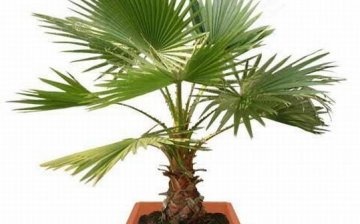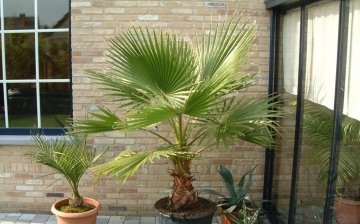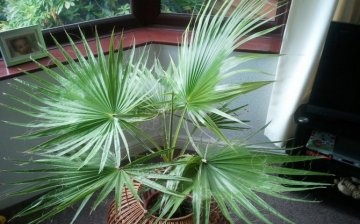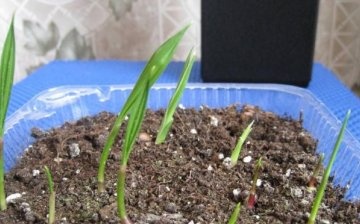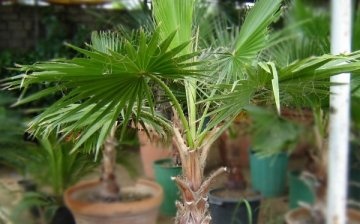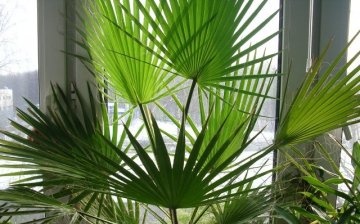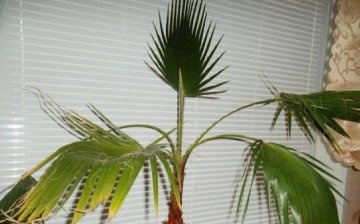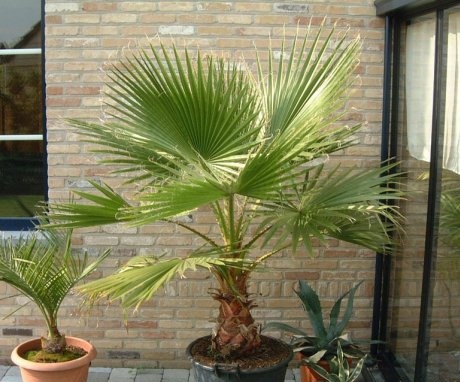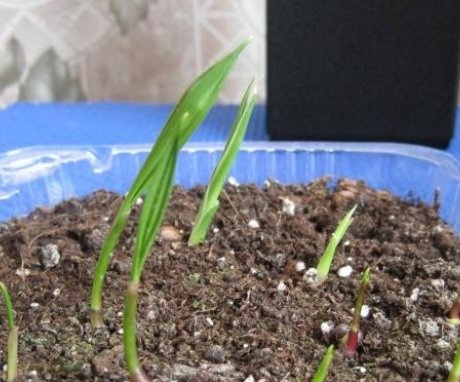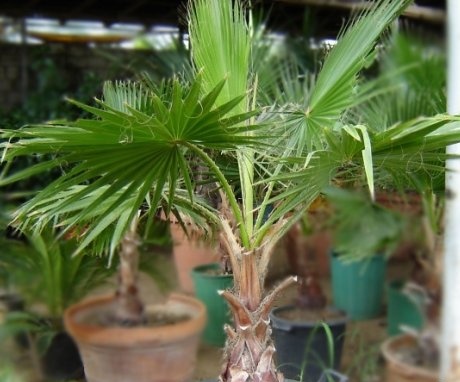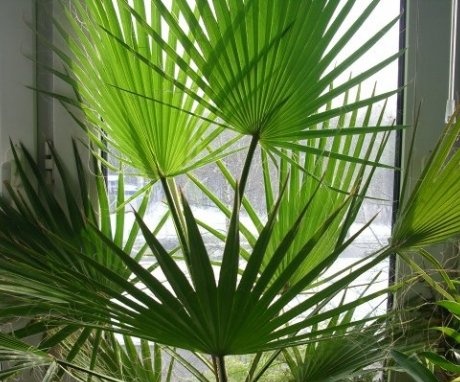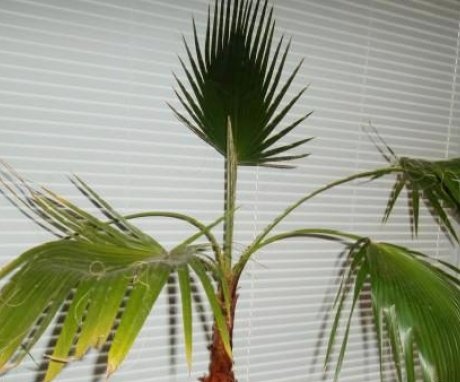Washingtonia filamentous: how to grow a palm tree at home?
Washingtonia got its name in honor of President George Washington, because it got its distribution from the south of the United States and northern Mexican regions. The plant is also called a palm tree in a children's skirt. This is due to the fact that the dried leaves do not fall, but fall onto the trunk, forming a kind of skirt. Then these leaves are cut off, and on the trunk there are notches and thorns, which are a distinctive feature and decoration of palm trees.
Washingtonia filamentous or filamentous is distinguished by rich green fan-shaped leaves, decorated with fibrous thin threads, like a cobweb. In their historical homeland, the stem stalks of the plant are usually boiled and eaten, and the seeds are used for the production of flour. There were also found use of fibers that are suitable for weaving rugs and baskets.
Content:
- Washingtonia filamentous - acquaintance with the palm tree
- What conditions are needed for the comfortable growth of a plant
- How can you propagate a palm tree
- Transplant requirements
- How to care for washington at home
- What can harm the plant
Washingtonia filamentous - acquaintance with the palm tree
In the natural environment, Washingtonia filamentous is a tall tree up to 20-25 meters. Its leaves, similar to a fan and entangled with whitish fibrous filaments, are formed by linear segments and are concentrated in the upper part of the trunk. The leaves are held on short smooth petioles, the edges of which are framed by back-curved strong short thorns.
Washingtonia flowers are represented by long paniculate inflorescences and spread a pleasant aroma. Due to the presence of female and male flowers, the palm tree can do without pollinators.
After flowering, which is rare at home, black berries are formed containing brown seeds.
The palm fruit can be eaten, which is what the Indians do. The fruits are also food for birds, which peck out the sweet pulp, freeing the seeds. Washingtonia filamentous palm is resistant to frost, it can grow in open ground at a temperature of 15 degrees below zero. If the temperature drops below this indicator, then the plant sheds all foliage, which quickly recovers with the restoration of warm weather.
What conditions are needed for the comfortable growth of a plant
Washingtonia filamentous is well suited for growing in subtropical climates. The plant prefers bright areas of a house or greenhouse, but it can grow in a small shade, but shade slows down its growth and development. If there is not enough light, then the leaves stretch and weaken, which negatively affects the decorativeness of the palm tree.
That is, the more light washingtonia receives, the faster the growth of fan leaves appears.
The plant does not need spraying, and the dust is removed with a damp sponge. Small palms can be used for warm, low-pressure showers. If leaves and petioles bend during water procedures, they will no longer recover and the palm tree will look sloppy.
Washingtonia filamentous does not relate well to transplanting, therefore, the young are reloaded, be sure to keep an earthen lump, and without damaging root system... And in mature plants growing in flowerpots of large volume, it is enough to replace the top layer of soil 5-7 cm thick. In the condition of the room, the Washingtonia palm tree lives on average for 10 years. She does not like drafts and the proximity of heating devices.
How can you propagate a palm tree
Washingtonia filamentous is stingy for layering, so its reproduction occurs exclusively seeds... This will take a lot of patience. It is not enough to simply purchase seeds and submerge them in the ground.
To grow seedlings, you need to follow some rules:
- Seed preparation. Only fresh seeds are suitable for planting: the longer they lie, the longer it will take germination... To speed up the process, the seeds are processed - a dense lignified shell is carefully filed along the joint and soaked in water for 4-6 days. In this case, the water needs to be changed daily.
- Preparing the soil mixture. To germinate seeds, you need to take steamed sawdust, disinfected moss and calcined sand in equal proportions.
- Sowing. Soaked seeds are placed in the prepared substrate to a depth of no more than one centimeter and watered. From above, the crops should be covered with a transparent dense material (polyethylene or glass) and kept at a temperature of 28 degrees and moderate humidity.
- Picking... Depending on the freshness of the seed, the first shoots will appear in 2-8 weeks. When the first shoots appear, the plants should be moved to a bright place, but not in direct sunlight. When the seedlings gain strength and get stronger, you need to make a dive. Young palms are planted in separate containers with a diameter of 6-9 cm. This should be done with extreme caution in order to prevent damage to the root system and breakage of the cotyledons from which the seedlings feed.
The composition of the soil for the dive includes light soddy-leafy soil, humus and a little sand in a ratio of 2: 1: 1. With the right approach, the seedlings will quickly begin to grow and by the age of one year they will acquire 4-5 whole leaves. The division of the leaves into segments occurs after the palm has released the eighth leaf. It is then that the plant takes on a decorative appearance. You can omit the picking stage and plant the seeds in separate containers as soon as the boring reaches one centimeter.
Transplant requirements
Planting and transplanting Washingtonia filamentous is carried out in ready-made soil for palm trees or prepared independently: a mixture of sod-humus and leafy soil (2: 1: 1) with sandy admixture.
It is customary to carry out the transshipment of Washington in the spring, before intensive development begins.
Young specimens are transplanted infrequently - once every two years. Upon reaching seven to eight years - every three to four years. At a later age, 5-10 cm of the upper layer of soil is replaced. Palm trees are bad for transplants and after the procedure they can hurt for a long time. Therefore, such manipulations should be carried out as needed, when the root system grows throughout the pot or the soil has become unsuitable for further growth.
For growing palm trees, wooden containers or volumetric flowerpots with a high-quality drainage layer are suitable. Periodically, the roots come out of the soil, remaining on top, and they need to be sprinkled with fresh substrate.
How to care for washington at home
In a house or apartment, the palm tree grows compactly and it is easy to care for it. If you have an idea of the nuances of growth, Washingtonia, you can create conditions similar to natural ones.
Caring for a palm tree, you need to ensure:
- access to a sufficient amount of light. The plant grows well in bright, diffused light. It should be located in rooms on the south side of the house. Young palms are especially demanding.Slightly shaded places are also suitable for adult specimens.
- air humidity within 65-85%. In summer drought, the palm tree should have a warm shower and wipe with a damp sponge
- regular irrigation. In summer watering carried out no more than once every 7-10 days, but abundantly. It all depends on the level of air humidity, the volume of the planting tank and the temperature regime. For the winter period, the plant retires, so it is watered as needed, but not allowing the earthen coma to dry out
- regular feeding, which is applied during the growing season twice a month. As a fertilizer, a complex fertilizing for palm trees and balanced mineral fertilizers with a high iron content are suitable.
Advice! For uniform foliage, the tub with a palm tree should be periodically rotated around its axis. If the tips of the leaves dry out, then they should be cut off. If the roots go outside the flowerpot, then the plant needs a transplant.
What can harm the plant
Washingtonia filamentous can be attacked by scale insects, spider mites and mealybugs. These pests prefer to settle on the leaves, stalks and stem of the plant. In the process of vital activity, insects suck out the sap of the palm tree, which leads to a weakening of the palm tree, the leaves of which wither, become stained and gradually fall off, provoking the slow death of the exotic beauty.
To prevent insect attacks, you need to maintain optimal humidity in the room and regularly wash the leaves with a soap-alkaline solution.
Also, by wilting, spotting and falling foliage, washingtonia signals a violation of the conditions of detention:
- Blackening and drying of the tips of the leaves indicates excessive dryness of the air and potassium deficiency in the soil, and browning of the foliage and the loss of decorativeness, especially in winter, indicates an excess or lack of moisture in the soil.
- A sudden and massive yellowing of the foliage indicates that the palm tree lacks nutrients or they are poorly absorbed by decay and other diseases of the root system.
- If the lower leaves of Washingtonia filamentous turn yellow and fall off one by one, then you should not worry - this is a natural natural process. The leaves are removed with a sharp knife.
Observing all the rules for boarding and subsequent agrotechnics, as well as showing a little endurance and patience, you can decorate the house with an exotic guest of Washington.
She is able to revive and dilute even the most austere interior. It is not for nothing that palm trees are actively grown to decorate offices and shops, giving the premises respectability and aesthetics. And even if the plant does not please its owners with flowering, then its spectacular appearance compensates for this.
More information can be found in the video:



